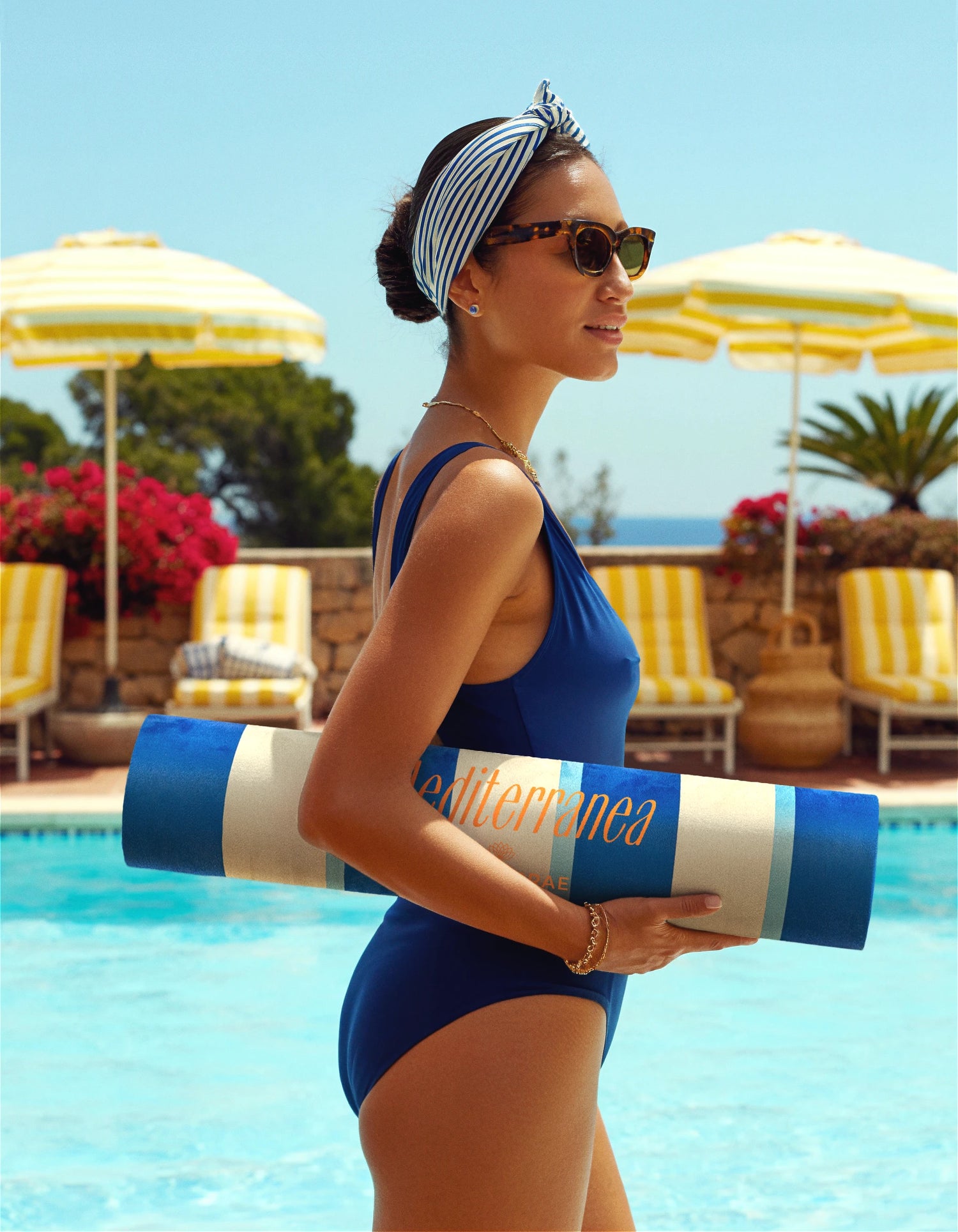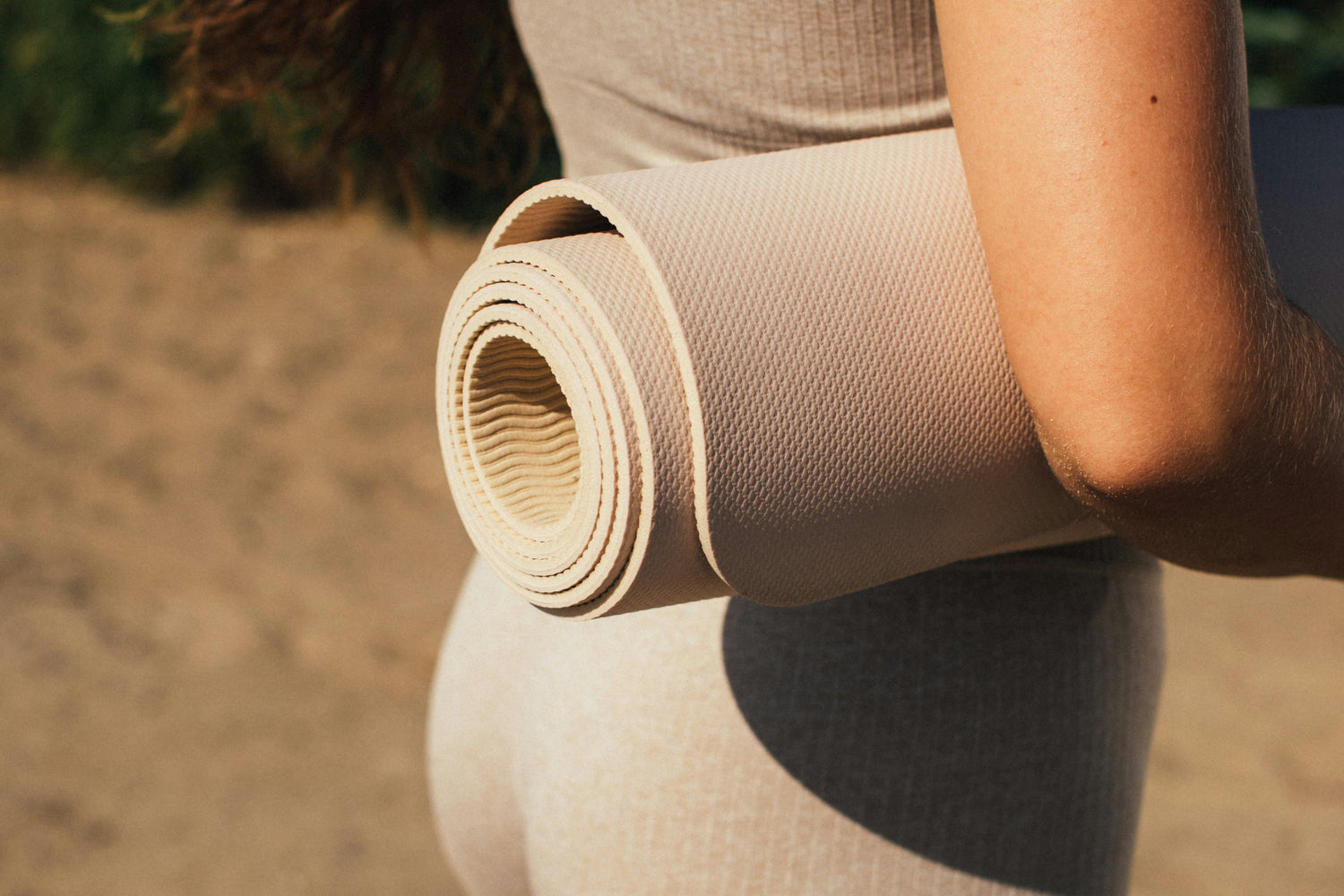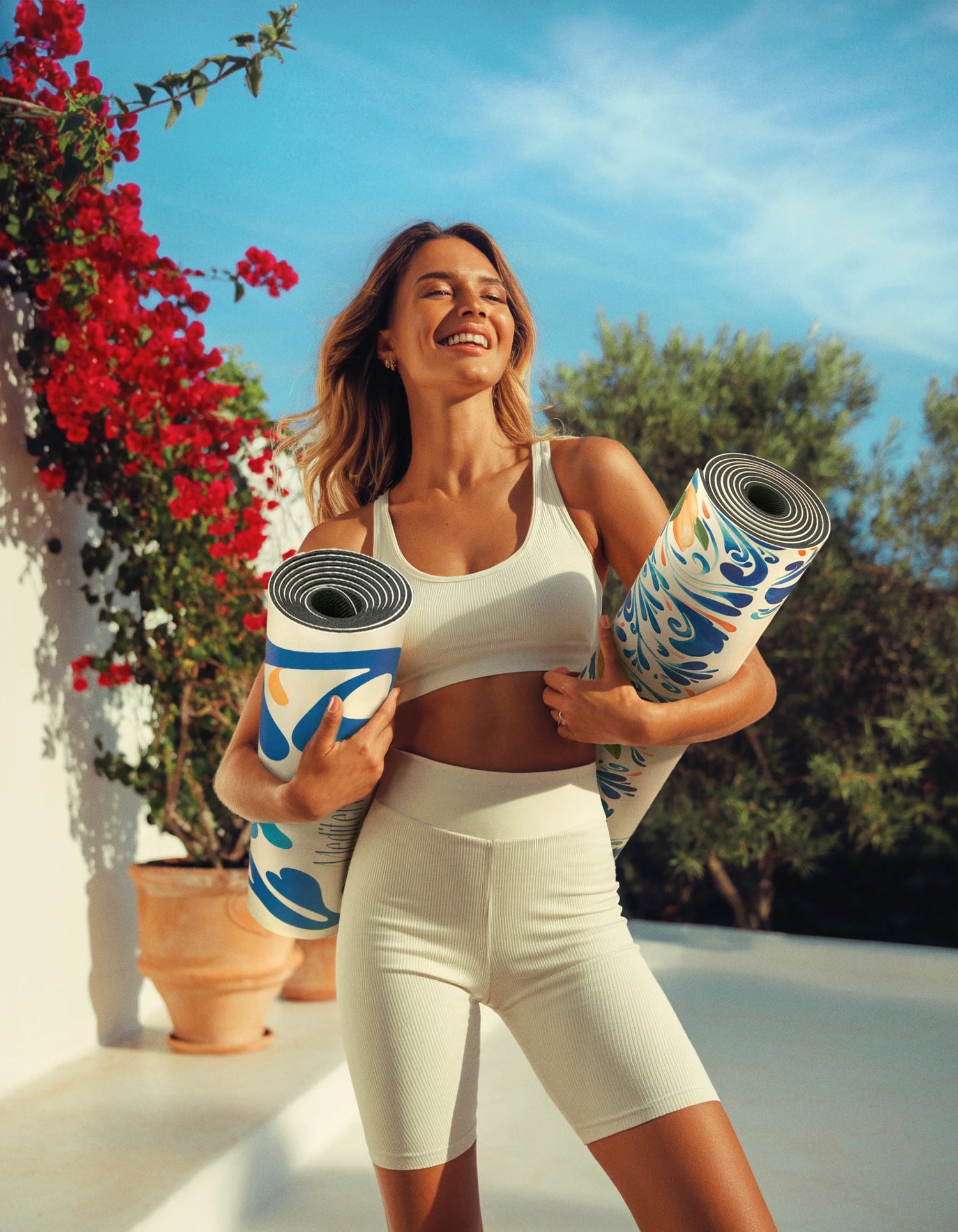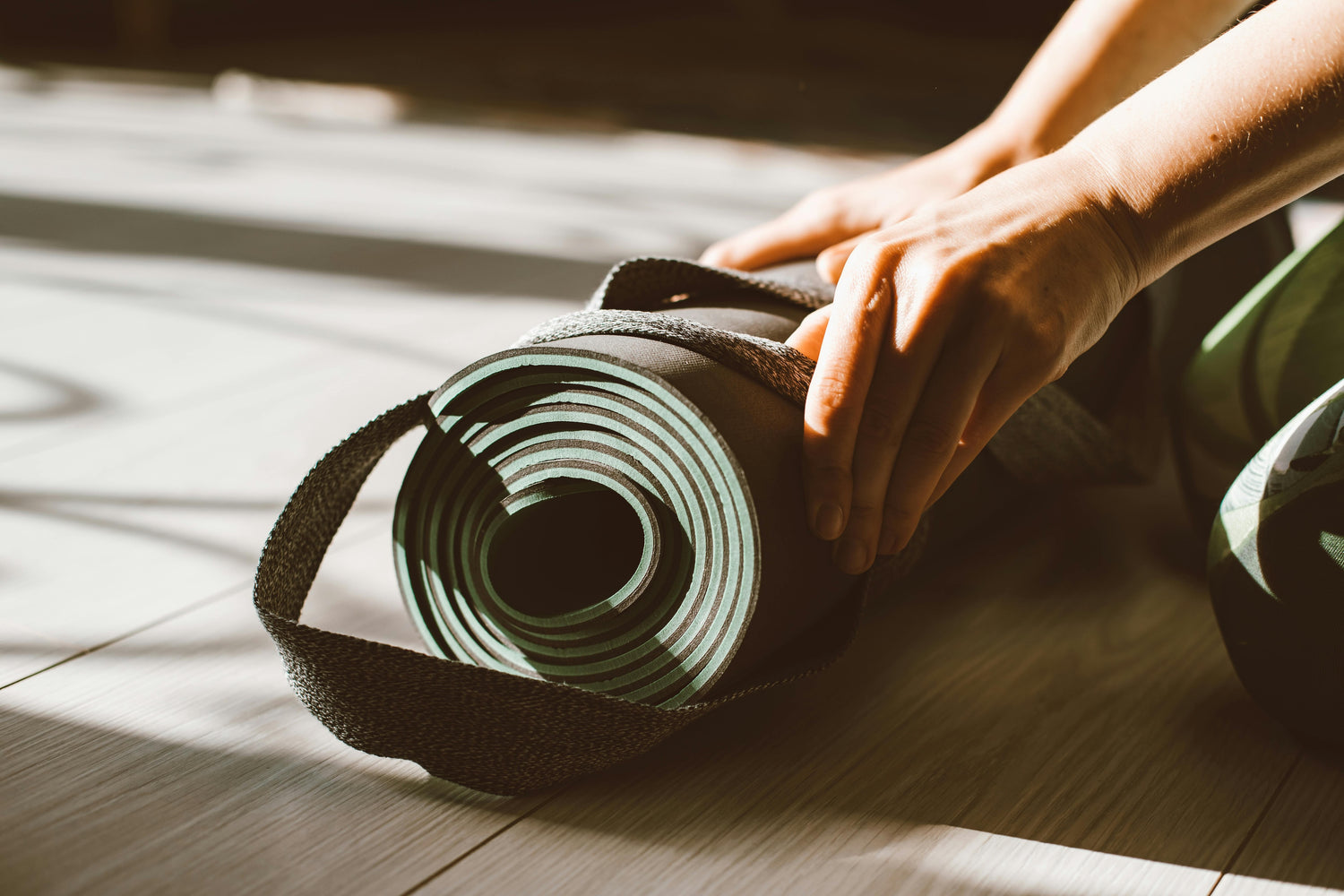WHICH YOGA MAT TO CHOOSE: THE 6 PERMANENT QUESTIONS ON THE INTERNET
Which yoga mat should I choose? This is often the first question, and sometimes the most difficult. Between materials, thickness, adherence and respect for the environment, it's not always easy to find the right mat. However, this search speaks volumes: it reflects the desire to practice in good conditions, on a support worthy of your commitment.
At Yogaterrae, we've listened, observed, practiced and collected here the 6 big questions that web users ask all year round. And for each question, we've come up with an enlightened, benevolent answer based on experience.
Written by TINA - July 2025
Reducible content
Reading time
Approx. 10 minutes
WHAT YOU'RE ABOUT TO DISCOVER
- Which yoga mat to choose when you're just starting out, without mistaking either the material or the use.
- The ideal thickness for a balance between joint comfort and postural stability.
- The different materials (TPE, cork, natural rubber...) and their impact on practice and the planet.
- The right size or format for your body type, yoga style or need for mobility.
- Simple care instructions to preserve your carpet over time.
- And finally, a tricky but frequent question: why do some carpets slip, and how can I find a real non-slip model?
"Let's take a look!

WHICH YOGA MAT TO CHOOSE FOR BEGINNERS
When you start yoga, you don't always know what you're looking for, but you sense what you want to avoid: a mat that slips, that tears, that hinders more than it supports. The right mat is the one that puts you at ease from the very first posture, without making you doubt every movement.
But starting out also means not yet knowing your own style. Maybe you'll try a gentle Hatha class at home, then a dynamic Vinyasa in the studio... That's why you need to choose a versatile mat that offers comfort, stability and safety.
If you're practicing at home on a hard floor, or if you need to protect your knees and wrists, opt for a soft mat, around 6 mm thick. Our STUDIO ORIGIN models, in two-tone TPE foam, are perfect for first explorations: they're light, thick and easy to store, and their soft texture is reassuring. They're the ideal companion for discovering pressure-free postures.
If you sweat easily, or if you're aiming for a more toned practice (Vinyasa, Power Yoga), choose a mat with a very non-slip surface. You have two choices:
- natural rubber with PU surface, as in our MAUNA KEA range: exceptional grip even when dry, perfect stability for warriors, boards and inversions, with a firm, elegant feel.
- sueded microfiber, soft to the touch when dry, but which becomes grippy with humidity: ideal for those who sweat a lot or practice barefoot. Our NIRVANA VOYAGE collection in microfiber + rubber even offers foldable, washable models, perfect for uncompromising beginners.
And if you're looking for a more natural, more sensorial material, our TERRES DE LIÈGE range could be just what you're looking for: a warm surface, great barefoot grip and eco-responsible support.
In a nutshell:
- For a comfortable start → TPE (STUDIO ORIGIN)
- For maximum dry grip → PU + natural rubber (MAUNA KEA)
- For sweaty practice → Suede microfiber + natural rubber (NIRVANA VOYAGE or CONFORT)
- For a natural, textured feel → Cork + natural rubber (TERRES DE LIÈGE)
The best mat to start with is the one that takes you from where you are to where you want to be tomorrow. Yours doesn't have to be perfect, just right for you.

IDEAL YOGA MAT THICKNESS FOR A PERFECT BALANCE BETWEEN COMFORT AND STABILITY
We often think that a yoga mat is "just a question of material". Butthickness plays a decisive role, especially when you're just starting out. Too thin, and the mat can quickly become a source of discomfort: knees banging against the floor, wrists getting hot, lumbar vertebrae struggling to settle. Too thick and the mat becomes unstable, making it more difficult to maintain balance. The ideal thickness depends on several criteria: your body type, how your joints feel, your yoga style and the type of floor you practice on.
If you're starting out with gentle sessions such as Hatha or Yin Yoga, it's best to opt for a mat around 6 mm. That's what the STUDIO ORIGIN range offers, in two-tone TPE: good cushioning, light weight ideal for transport, and a soft texture that ensures safe support. This type of mat is also ideal for people with sensitive knees or those returning to activity.
For more dynamic practices such as Vinyasa or Pilates, stability is a priority. A mat between 3 and 4 mm provides a better connection to the floor, without loss of balance. This is the case with our MAUNA KEA range, in natural rubber with PU surface, which offers firm density and excellent grip. This type of mat enables fast sequences and good support in demanding postures.
If you're practicing on an already soft floor - carpet, rugs or floating parquet - a mat that's too thick can actually increase instability. In this case, a thinner but denser model is preferable to regain a secure footing.
Finally, if you're often on the move or looking for a compact mat, the NIRVANA VOYAGE 1 MM models, in suede microfiber and natural rubber, are foldable, washable and easy to transport. For greater comfort, while retaining the anti-slip properties of microfiber, the NIRVANA CONFORT 3.5 MM version provides better support for more regular practice.
Thickness isn' t everything. The density of the material plays an essential role in the feeling of comfort and the quality of anchorage. Two mats of the same thickness can offer a very different experience, depending on their composition.

DIFFERENT MATERIALS AND THEIR IMPACT ON PRACTICE AND THE PLANET
Behind the word "yoga mat", there's actually a multitude of materials. And each one influences the quality of your practice, the sensation underfoot, the stability in the postures, and the environmental impact of your choice. The material is the soul of your mat. It determines everything: comfort, grip, maintenance, longevity... and even ethics.
Entry-level models are often made of PVC. While it has the advantage of being inexpensive and moisture-resistant, this material is neither recyclable nor biodegradable. It sometimes contains controversial substances, making it a less and less recommended choice - especially when you're looking to align your practice with values that respect your body and the planet.
A softer alternative is TPE (thermoplastic elastomer), a lightweight foam that contains no latex or phthalates, and can be recycled through certain channels. It offers a good compromise between comfort and safety for beginners. This is the material used in the STUDIO ORIGIN range, with its two-tone mats that are light, soft and easy to transport.
If you're looking for a more high-end, high-performance mat, turn to natural rubber. It's one of the materials most appreciated by demanding yogis: dense, robust, with good ground anchorage and great durability. In the MAUNA KEA range, this rubber is combined with a PU (polyurethane) surface, for exceptional grip even when dry. This combo is perfect for dynamic, fluid practice, where the mat becomes a real partner in movement.
Another remarkable material is cork. Derived from the bark of the cork oak tree, it is naturally non-slip, antimicrobial and very pleasant to the touch. It's ideal for both gentle and vigorous exercise. Our TERRES DE LIÈGE models combine this plant-based surface with a natural rubber base for perfect stability.
Finally, soft, absorbent sueded microfiber is ideal for those who sweat a lot or practice in heated studios. It is designed to grip better with humidity. This is the case with NIRVANA VOYAGE 1 mm for a thin, foldable and washable version, or NIRVANA CONFORT 3.5 mm for better support while retaining that textile feel.
Each material has its own truth, and none is universal. Choose according to how you feel underfoot, how you move, how you inhabit the posture. And if possible, choose according to how you respect living things.

THE RIGHT SIZE FOR YOUR BODY TYPE, YOGA STYLE OR MOBILITY REQUIREMENTS
We often talk about material, grip, thickness... but the format is just as essential. Choosing a mat with the right dimensions means avoiding unnecessary adjustments, feet that stick out, wrists in the air or constant discomfort during your session. A good mat should accompany your movements, not constrain them.
The "standard" format measures around 60 cm wide by 180 cm long. It's suitable for most practitioners, especially if you're under 1.75 m tall and practice indoors on a neutral floor. This is the format adopted in our STUDIO ORIGIN (183 x 61 cm) and TERRES DE LIÈGE (183 x 66 cm) collections, designed for comfortable, balanced practice.
In the MAUNA KEA range (183 x 68 cm), these more extensive models allow you to perform a series of postures without feeling limited by space. This type of mat is particularly popular with tall men, but also with those who do dynamic salutations or practice with accessories.
Width is also important. If you like reclining postures, twists or relaxation exercises, a slightly wider mat (66 or 68 cm) can provide a real sense of openness. That said, beware of space constraints: in a studio or hall, standard dimensions are often required to avoid disturbing your mat neighbors.
Some specific practices also call for special formats. NIRVANA VOYAGE 1 mm mats, for example, are designed to be ultra-light, foldable and space-saving. They measure 183 × 61 cm but can easily be slipped into a backpack. This format is ideal for those who travel frequently, or who wish to practice on a rental mat covered with their own hygienic backing.
Finally, if you're looking for a space of your own, at home, to create a real ritual of practice, you can even opt for a round mat from the TERRES DE LIÈGE range (diameter 135 cm). It invites a different freedom of movement, and is particularly suited to intuitive yoga, meditation or multidirectional stretching. These circular mats are also available from Yogaterrae, with a design designed to reorient practice around the center of the body.
In short, adapt the size of your mat to your morphology, your environment and the way you move. A mat that's too small will hold you back. A mat that's too big and badly chosen will become cumbersome. Ideally, it should blend in with your practice, while fitting you perfectly.

SIMPLE CARE INSTRUCTIONS TO PRESERVE YOUR YOGA MAT OVER TIME
A yoga mat is like a second skin: you breathe on it, you sweat on it, you relax on it. So it deserves special attention. Not only for hygienic reasons, but also to prolong its lifespan and maintain a pleasant practice, without odour, slippage or alteration of texture. And good news: you don't need to buy expensive sprays or specialized products to maintain it properly.
It all starts with regularity. A light cleaning after each session is often all that's needed: a damp cloth or small microfiber towel soaked in lukewarm water removes sweat and skin residues. You can add a few drops of white vinegar or mild soap for a natural cleaning and disinfecting effect. The important thing is to avoid aggressive products, chemical wipes or alcohol-based solutions, which can alter materials, especially natural rubber, microfiber or PU.
Once or twice a month, plan a slightly more thorough cleaning. Here again, there's no need to invest: a mixture of warm water, white vinegar (or lemon juice) and antibacterial essential oils such as lavender or tea tree is all you need. Spray on, leave for a few moments, then wipe off carefully. Never immerse your carpet completely in water, unless it's been designed to do so (like certain very fine microfiber models in the NIRVANA VOYAGE machine-washable range). Stagnant humidity is one of the carpet's first enemies: it can cause mildew or irreversible deformation.
Drying is just as important. Always lay your rug flat or loosely rolled, in a dry, well-ventilated place, out of direct sunlight. UV rays can alter natural materials, fade colors and weaken non-slip surfaces. Also, avoid folding while still damp: this creates marks and points of fragility.
Last but not least, don't forget that good maintenance also means good use. Don't walk on your carpet with shoes on, don't store it loose in a damp corner, and use a carrying strap or bag to protect it when you're on the move. A well-maintained carpet can last for years. And often, the simplest gestures are the most effective.
Caring for your mat means caring for your practice tool - but also for your space, your body and your consciousness. It's not a constraint, nor an obsession: just a little ritual that extends the intention with which you started.

WHY SOME YOGA MATS SLIP AND HOW TO FIND A REAL NON-SLIP MODEL
This is undoubtedly one of the most frequent feedbacks from practitioners: "My mat is slipping, I'm losing my balance, I can't anchor myself." This slipping problem can turn a pleasant session into a tense moment. It has several causes, and fortunately, several solutions - provided you understand where the problem comes from.
First, we need to distinguish between two types of glide. The first concerns carpet that slips on the floor. This often happens on smooth tiles or parquet, especially with very light or old carpets. In this case, the problem often comes from the underside of the carpet. A material like TPE can sometimes lack grip if it's too worn. Conversely, natural rubber offers a much more reliable anchorage to the floor, thanks to its density and slightly rough texture.
The other type of slippage is that felt on the carpet surface, when hands or feet slip in posture. This phenomenon depends on a number of factors: the material, thehumidity, the ambient temperature... and, above all, your perspiration. Paradoxically, some carpets slip more when dry, whereas they become very slippery when damp. This is the case with the sueded microfiber used in our NIRVANA VOYAGE 1 mm and NIRVANA CONFORT 3.5 mm ranges. This type of surface is ideal if you tend to perspire or if you practice in a heated room.
If you don't perspire much, and are looking for immediate dry grip, turn to PU (polyurethane) surfaces like those in the MAUNA KEA range. These mats have been designed to offer optimum grip right from the start of your session, without waiting for moisture. The grip is clean, precise and secure, even in the most demanding postures.
Finally, don't forget that cleaning plays an essential role. Residues of dust, moisturizer or perspiration can create an invisible film that impairs grip. A well-maintained carpet, cleaned with lukewarm water and mild soap, will often regain its original grip. It's also a good idea to practice barefoot with clean hands, to avoid saturation of the carpet surface.
If you still experience persistent slippage, the addition of an absorbent towel or a thin textile layer can temporarily compensate, until you find a mat more suited to your morphology and intensity of practice.
A carpet that slips is a carpet that brakes. And sometimes it's not your posture that's the problem, but simply the support you're resting on. Look for the material that suits you, and let it become an extension of your anchorage.
Thank you TINA for this post
Thank you for taking the time to read these answers. We hope they will help you move forward with greater clarity, comfort and confidence on your carpet - whatever it may be.
TINA's bio
-

TINA
1994, Reunion Island & Mauritius, a Life inspired by the Indian Ocean and Yoga
Since childhood, this intrepid traveler has criss-crossed the globe, leaving her footprints on beaches the world over.Passionate about surfing, scuba diving and sailing, she has made the ocean her playground and source of inspiration.
The freedom of the waves, the serenity of the ocean depths and the wind in his sails have punctuated his journey, always guided by a quest for connection with nature.
Through her explorations, yoga has become more than a practice for her - it's a way of life.
Between morning surf sessions and meditative sunsets, she has found in yoga a perfect balance of strength, fluidity and self-awareness.
Today, she combines her passion for water sports with teaching yoga and is part of the Yogaterrae team, here in France, in the South-West and often remotely :)
This adventuress is a true source of inspiration for anyone who aspires to live in harmony with their body and nature.
Through her stories of incredible experiences, she invites everyone to open up to a world where every wave, every breath and every posture is a celebration of life.



